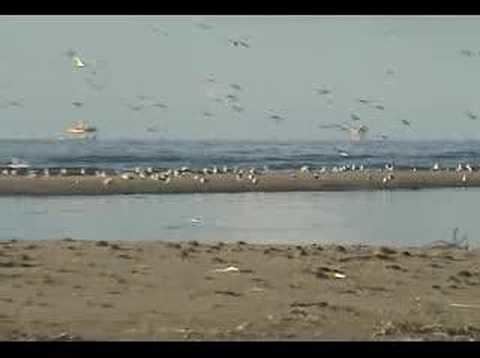- land 3.625 sq mi (9 km) Area 108.8 km² | - summer (DST) CDT (UTC-5) Area code 504 | |
 | ||
- water 38.375 sq mi (99 km), 91.37% Parish Terrebonne Parish, Louisiana | ||
Last Island (Official name: Isle Dernière, often misspelled as Îsle Dernière, Isle Dernier, L'Îsle Dernière, Île Dernière, etc. ) was a barrier island and a pleasure resort southwest of New Orleans on the Gulf Coast of Louisiana, United States. It was destroyed by the Last Island Hurricane of August 10, 1856. Over 200 people perished in the storm, and the island was left void of vegetation.
Contents
Map of Isles Dernieres, 9, LA 70344, USA
After the hurricane destroyed the island, it became known in the plural Isles Dernières (Last Islands) in French. The highest points were under 5 ft (1.5 m) of water.
Last Island was south of Dulac, Louisiana, between Lake Pelto, Caillou Bay, and the Gulf of Mexico. The island was originally approximately 25 miles in length before being split in half by the storm; but today only small pieces of several smaller islands remain.
As a result of the hurricane and subsequent tropical storms, Isle Dernière was fragmented into five smaller islands: East, Trinity, Whiskey, Raccoon, and Wine (a.k.a. Vine Island). The western end of the remaining westernmost island is known as Raccoon Point. The remnants of Last Island are now a haven for pelicans and other seabirds. Part of the Isles Dernières chain is the Terrebonne Barrier Islands Refuge, which encompasses three islands, Wine, Whiskey, and Raccoon, and is closed to the public. The closest village is Cocodrie, which is about 13 miles northeast of Trinity Island.
In 1788, Spanish governor Esteban Miro granted Isle Longue to Jean Voisin prior to the establishment of Lafourche and Terrebonne Parishes, but then known as Jefferson Parish all west of the Mississippi River; this broad coastal area was then known as Barataria. Jean died in 1820 in Pointe à la Hache, leaving all his properties to his son and daughter. Jean Joseph Voisin and Catherine Voisin. By 1824, Catherine had died and Jean Joseph married and moved onto the island for the fishing industry. Problems with land offices in LA recording in DC, and land on the island was sold and Jean Joseph filed a suit in Terrebonne Parish court, in the late 1840s — which litigation continued until the Civil War, when the courthouse was closed down by Union officials.
Jean Joseph Voisin and his family were living on the island in 1856 when the Great Storm came; he lost his wife Amelie Clause and daughter Amelie Voisin, who was about 9 years old. He remarried and died around 1890 and is buried in Plaquemines Parish at Pointe à la Hache Catholic cemetery, which was later taken by the River, and reburied further inland in that same cemetery. Voisin descendants are still filing lawsuits to reclaim their lands.
The Bayou [which?] was known as Voisin Bayou and the Bay {which?] was called Bay Voisin, back then. The lake where the daughter's body was found after the storm was then named for her, "Sista" Lake; they called her Sister as she had the same first name as her mother. T.V. Hebert of Voisin Descendants Assn., Terrebonne Parish, La.
Resort at Last Island
Before the hurricane, Isle Dernière (Last Island) was a popular resort where people could enjoy white sand beaches and clearer water, which are not found on the marshy mainland. Last Island was also known for an almost continuous breeze, which would have been welcomed by those escaping the suffocating heat of the mainland. Accommodations included the John Muggah's Ocean House Hotel, and for entertainment there were several gambling establishments and the Captain Dave Muggah's Billiard House. Several hundred yards to the west of the hotel was the settlement known as Last Island Village which consisted of approximately 100 beach homes, some "fine" houses and other temporary summer houses.
Regular steamer service to the island was provided by the Star from Bayou Boeuf. The New Orleans, Opelousas and Great Western Railroad provided a connection to Bayou Boeuf from Algiers, La., a short ride on the Algiers Train Ferry across the Mississippi River from the French Quarter landing at St. Ann Street. Regular railroad fare was $3.50 with half-fare for children and servants. (New Orleanians could take the Algiers passenger ferry.)
Every structure on the island including the hotel, a large, two-story wooden structure of considerable strength, was destroyed. See: 1856 Last Island Hurricane.
